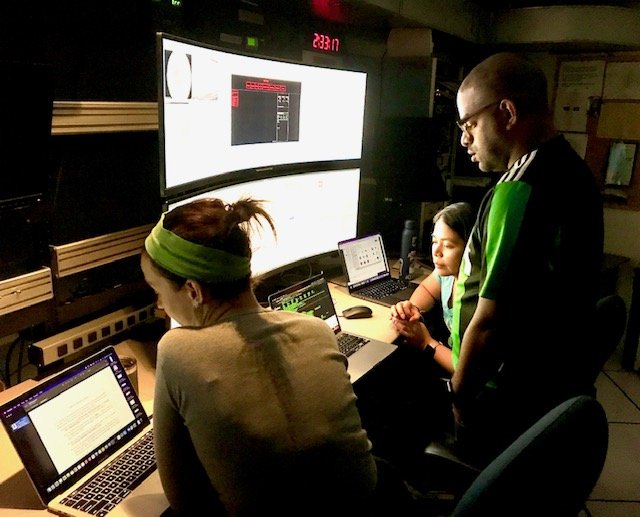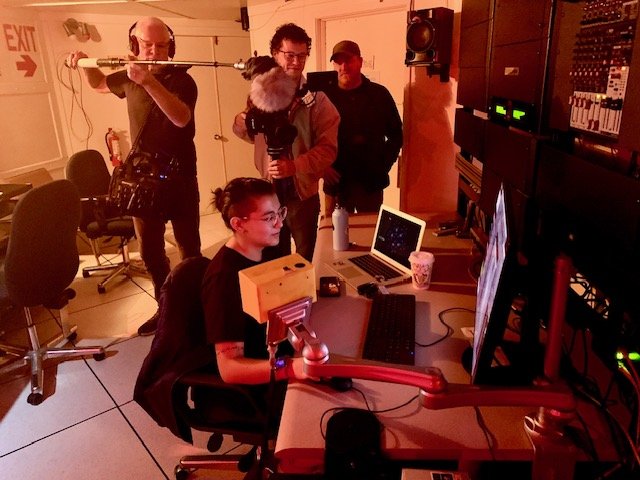The Stars in Their Eyes
As the sun sets behind the Davis Mountains of west Texas and the temperature in the high desert begins to fall, work is just beginning. An astronomer begins to open the doors of a giant white domed observatory to begin their night’s work. Below the mountain tops three huge telescopes, the parking lot of a visitor’s center is filling up as hundreds of people slowly walk to an open-air amphitheater, awaiting the dark and the beginning of a star party. As the twilight turns to night, the Milky Way and a sky full of stars appear, brilliant in ways that most people in cities and suburbs have never seen. This is just another night at one of the gems of the astronomy world, the McDonald Observatories. The Stars in Their Eyes will be a film about year in a place that no one who works there or visits ever forgets.
Initial funding from the Hobby Family Foundation.
Summer Milky Way over the McDonald observatories.
The Stars in Their Eyes is a portrait of the colorfully disparate, ever-changing cast of characters at the McDonald Observatory and in the surrounding communities in far West Texas, where people from all over the world converge for something wholly untouchable: the night sky. It’s also about the alarming loss of dark skies, declining ten percent worldwide every year. And about the challenge of older observatories like McDonald, so important for teaching, for attracting visitors, and for ongoing research, to remain relevant in an era of space-based telescopes and giant observatories being built in Chile. Will McDonald survive? And will the next generations ever see a sky full of stars in their lifetimes.
The film is being directed by Paul Stekler, a nationally known award-winning filmmaker and the former chair of the Department of Radio-Television-Film at the University of Texas at Austin. All of his documentaries over four decades have been broadcast nationally on PBS. After the finished film airs, The Stars in Their Eyes will be given to McDonald Observatory for their use at their Frank N. Bash Visitors Center and online for observatory support.
The Stars in Their Eyes will spend a year at the McDonald Observatory, capturing the people who work in and visit this celestial place that’s home to the Hobby-Eberly Telescope, one of the world’s largest, and is one of the world’s leading centers for astronomical research. The film will also be both a portrait of people at the observatory – staff, scientists, students and visitors -- along with placing it in the context of the surrounding communities in far West Texas high desert.
Hobby-Eberly telescope.
Dr. Hawkins in the control room of a 107-inch telescope with two of his advisees, UT graduate student Maddie Lucey and post doc Dreia Carrillo.
The film will interweave the stories of astronomers from the University of Texas and from around the world who make groundbreaking discoveries about the origins of the universe through the study of ancient light. It will include graduate astronomy students working on their doctorates; the student interns who lead visitor tours; maintenance workers who live on and around the mountain; kitchen workers at the astronomer’s lodge: craftspeople who clean the telescope mirrors; the public school teachers and students who attend summer workshops, and the thousands of visitors who sojourn to what feels like the middle of nowhere for a star party beneath one of the darkest night skies in the continental United States.
The film will feature astronomers like Dr. Keith Hawkins, a charismatic young professor at the University of Texas at Austin, who specializes in Galactic archaeology, exploring the formation, evolution, and structure of the Milky Way galaxy, while mentoring a new generation of young women astronomers studying the compositions of old stars.
Anita and Bill Cochran beginning a night’s observation.
Viewers will meet Anita and Bill Cochran, who have worked at McDonald for over forty years, studying comets and exo-planets, respectively, and spending long nights using the observatory’s oldest telescope, the Otto Struve. Then there’s staffers like Jimmy Crooks and Emily Mrozinski. Crooks is an onsite mechanic and Jack of all trades who drove by McDonald on his motorcycle and never left. Mrozinski is the crane operator in the Hobby-Eberly dome, charged with rearranging the telescope’s giant reflective mirrors for each night’s work. Her daily routine couldn’t be more different than that of the observatory’s Dark Skies coordinator Stephen Hummel, whose work takes place largely outside McDonald. His job: to minimize light pollution, so Hummel spends the bulk of his days in his pickup, driving around the vast expanse of west Texas, trying to convince folks in rural communities to change their outdoor lightening in a world where skies are losing 10% of their darkness every year. The Stars in Their Eyes will also introduce viewers to Rachel Fuechsl, who leads the McDonald’s infamous tri-weekly star parties, regaling rapt visitors with the science and mythology behind objects in the night sky.
Crescent moon over the 82 inch dome.
The Stars in Their Eyes will also educate viewers on the observatory’s rich history of scientific achievements since the dedication of McDonald’s original 82-inch reflector telescope, the Otto Struve Telescope, in 1939 followed by the larger 107-inch Harlan J Smith Telescope in 1968, and the Hobby-Eberly Telescope in 1997. These achievements include discovering an atmosphere on Saturn’s largest moon; calculating the precise distance between the earth and moon by bouncing a laser off a reflector left there by Neil Armstrong and Buzz Aldrin, during the Apollo 11 landing; the invention of a system for measuring the color of stars; the creation of an instrument for high-speed photometry that revolutionized the of study white dwarf stars; and the discovery of the most powerful supernova to date.
Filming archeologist Bob Mallouf at an ancient cave shrine in the Davis Mountains.
The film is also about the West Texas context of ranchers and residents who love the high desert, the mountains and the vast spaces. Fort Davis, an actual frontier fort once manned by African-American Buffalo soldiers, is rich in history. Archeologists, like retired state archeologist Robert Mallouf, study the cosmological meanings of pictographs left on rock walls in the surrounding Davis Mountains, in ancient shrines built in the caves on the sides of canyon walls, and in caches of buried broken arrowheads found at the peak of Mt. Livermore, overlooking the observatory. There are the efforts at conservation of the land and ecology of this northern Chihuahuan Desert. There’s the contrast of nearby working class, college town Alpine, tourist and artist magnet Marfa, and Fort Davis. And there’s the threat of wildfires in a changing climate that have come close to McDonald.
2011’s Rock House wildfire narrowly missing the observatory.
Why a film about the McDonald Observatory and its west Texas home? On one hand, the film will highlight a future where dark skies and our ability to see the night’s stars disappear. And then in a world where the buzz in astronomy is largely centered around telescopes in outer space and gigantic new facilities in Chile’s Atacama desert, the McDonald Observatory continues to hold its own as a premiere research and teaching institute. It is responsible not only for transformational discoveries about the planet’s history and solar system, but also for sparking wonder in multitudes of stargazers. And it deserves to be celebrated by a global audience. The Stars in Their Eyes will facilitate this by introducing viewers to the magic and beauty of the place, the telescopes, and the cast of endlessly entertaining characters who bring the McDonald Observatory to life, while making the science accessible and reminding people of all ages and backgrounds that profound beauty readily available to them every single day. They simply need to wait for the sun to go down then gaze upward at the night sky.
Malia Keo, UT Astronomy PhD student, running the 82” Otto Strove telescope.
A model for this film is Yosemite: The Fate of Man, a documentary made by MacArthur Award winner and multiple Oscar nominated filmmaker Jon Else. Set in Yosemite National Park, Else’s film interweaves vignettes featuring people who work in and visit the park with an historical narrative. The documentary is not only about the national park, but also about man’s relationship with and need for wilderness, and it as relevant today as it was thirty years ago, when the film was made. Director Paul Stekler has worked with Else on several projects and, for more twenty years, Stekler introduced UT production students to Yosemite as a paradigm of artful craftsmanship and powerful storytelling.
The Stars in Their Eyes will be produced as a feature length documentary for national television, particularly for PBS’s Nova science series. Beyond that, the film will be given to the McDonald Observatory for use both in the Bash Visitor’s Center and on the observatory’s website, and to aid in the observatory’s fundraising efforts. Supporting McDonald is an integral part the film project’s mission.
Funding
Staff research engineer John Kuehne playing violin in the 82” dome.
McDonald’s staff pose in front of the 82” dome on its 85th anniversary.
The Stars in Their Eyes received an initial grant of $100,000 from the Hobby Family Foundation for the purpose of attracting an additional $100,000 in matching contributions. We approached foundations and individuals, including those that have supported the observatory in the past. With the match now secured, we began filming this Fall.
We ‘ve raised $250,000 to date, half of our total budget of $500,000, a modest figure for a 90-minute feature documentary. The funds will cover all of the extensive on-site production for over a year, along with post-production costs that include a year of editing, music composition, additional astrophotography, pickup filming, sound mixing, and more.
The 90-minute feature documentary will be completed in 2025. After a festival run, it will be offered to PBS for a national broadcast, targeting PBS’s science series NOVA. Every single one of Paul Stekler’s previous films over forty years has been broadcast nationally on PBS.
After broadcast, the film will be given to the McDonald Observatory for use at their visitor center and online for their website and for the visitor center’s fund-raising.
All contributions to this project are tax deductible through the film’s fiscal sponsor The Center for New American Media, a 501C-3 non-profit sponsor of The Stars in Their Eyes (IRS #72-0860902)
Film dedicated to the memory of the couple who helped start this film, Ann and David Chappell.
Gifts to THE STARS IN THEIR EYES can be sent, by checks made out to the Center for New American Media and sent to:
Center for New American Media
59 Prospect Place, Ground Floor
Brooklyn, NY 11217-2281
Attention: McDonald Project
Louis Alvarez and Andy Kolker (718 789-2029) can provide any other details for sending the donation.









